 |
| As is sometimes the way, voicing a suggestion ‘wouldn’t
it be a good idea if ...’ develops into a task of previously unconsidered
vastness and evolves further into a project of such massive proportions
that it is in danger of collapsing under its own weight. |
| One can only take a deep breath now and suck a thoughtful
tooth at the gigantic amount of planning and toil that must have followed the decision the ‘combine’ took to use lighting technology previously untried on this scale — to abandon the simplicity and utility that white tiling offered — to devise over 40 unique geometric coloured patterns — to start the decoration using a company which had not made this kind of tile before and was ill-at-ease doing so - and to fix them to over 90 platform walls and associated passages. Oh, and to do it all in less than three years. A decision of epic proportions indeed. |
| |
| A typical scene at the end of the 20th century,
at Hampstead. All that endeavour to create these tile patterns at
the beginning of the century had become a distant memory. This is
what a lot of it looked like now. |
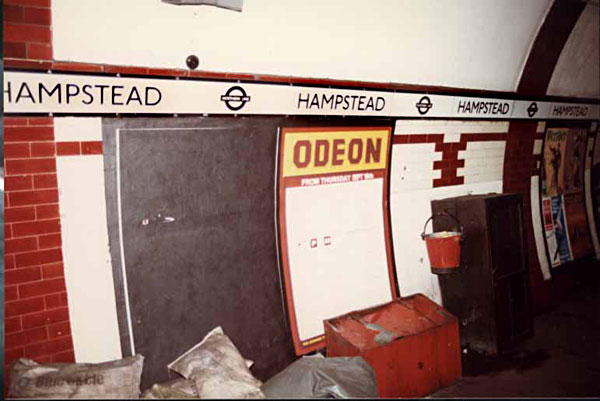 |
| |
| A similar ‘wouldn’t
it be a good idea if ...’ conversation
took place among a small group of individuals some 70 years later.
A little later in 1981, the conversation was repeated for my benefit
one quiet autumn evening. I was introduced to the fact that there
were dozens of central London stations with their own tile patterns
and colour schemes. |
| It was not that important a conversation - but the concept
did capture my imagination. As with the Yerkes syndicate's decision
to proceed, I seemed to have bitten off the proverbial too large a
mouthful. Fortunately, the major differences were, that I was blissfully
unaware of this, had no financial penalty to pay for my actions if
I had given up, and only my sanity could be questioned (even if I
succeeded). I had no major companies to start, nor any Financiers
or shareholders pulling at my coat for a return on their investment.
As it transpired, the Yerkes syndicate and their contractors concluded
their ‘wouldn’t
it be a good idea if ...’ in a very few years - mine
dragged on for well over twenty. |
| Between then and 2004, aided by a few others sharing
this interest, a systematic programme of surveying and research was
carried out to try and re-create what all those platforms had looked
like from the day they had opened. The most pertinent observation
was that hardly any of the original tiling could be seen over any
distance along any station wall. Over the years equipment rooms had
been added at the ends of most of the platforms, and in the middles
of some as well. Many stations had later received escalators, resulting
in reconstruction at platform level. Predominantly though, so much
was covered up with posters. |
| The photographs here show some of the work that
was carried out. The quest was to discover the position of every individual
tile, along the entire length of all the platforms. |
| |
| |
| A pattern panel at Elephant & Castle. It’s all
a bit of a mess really. |
|
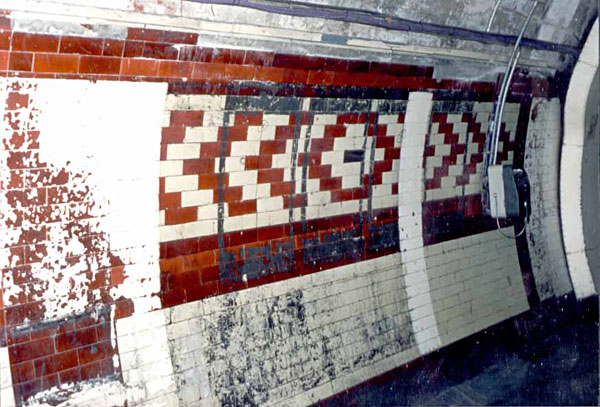
|
| |
| |
| Many stations still fully functional have disused
areas. The pictures below are from the end of one of the platforms
at Euston, which had not seen passenger activity since 1914 and was
filthy. During the early 1980s it received a visit from the bucket. |
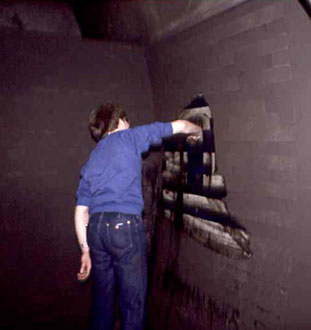  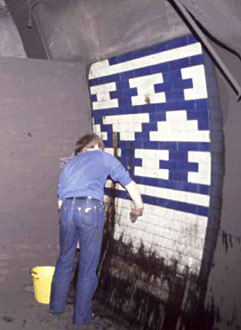 |
| |
| |
| Several stations had been renamed since they opened
and these usually had their former name panels painted over. Over
the 20-year project, numerous of these were targeted over night. Paint
stripper was used, as seen here on the Northern Line’s Tottenham Court
Road station. The original name, Oxford Street, had been covered up
since 1908. |
| Wherever this exercise was carried out, the complete
name panel was traced full-size, photographed and then painted over
again. This usually took most of the night-time hours when the trains
were not running. |
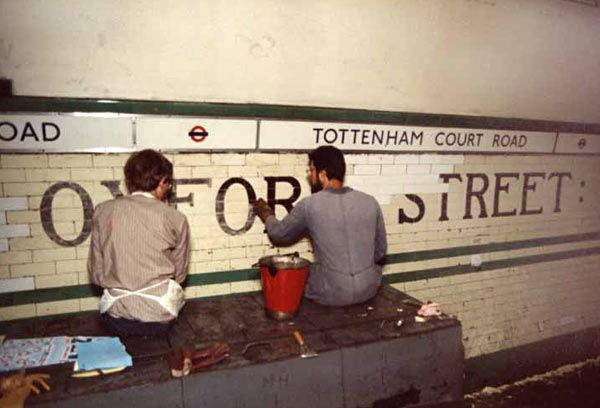 |
| |
| |
| Question: how many men does it take to scratch a painted
wall? Answer: four - one to do the scratching, one to point the torch*,
one to write it down - and one to photograph them doing it. York Road
(Piccadilly Line) had closed in 1932. The platform itself has been
removed and the walls covered in paint and decades of dirt. By making
a small scratch through the dirt and paint, one-by-one it was possible
to ‘see’ the colours of the tiles beneath. |
| *The brightness of this scene is of course misleading,
with the majority of the light coming from the camera’s flash gun. |
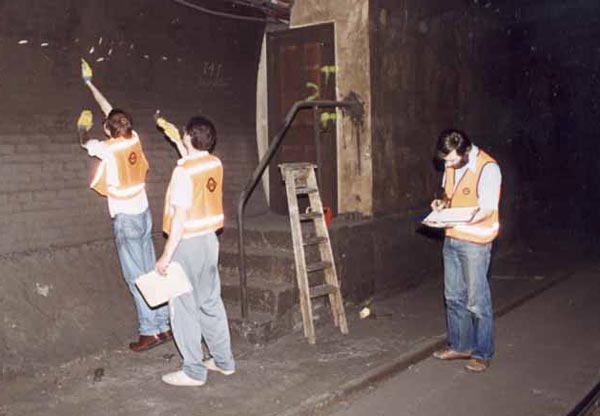 |
| |
| Go to next section >> |